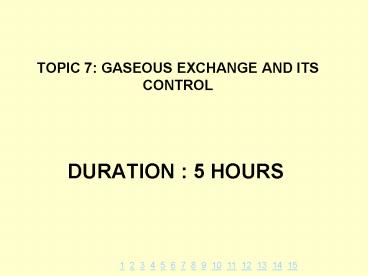TOPIC 7: GASEOUS EXCHANGE AND ITS CONTROL - PowerPoint PPT Presentation
1 / 15
Title:
TOPIC 7: GASEOUS EXCHANGE AND ITS CONTROL
Description:
detail structure of an alveolus. basic structure of haemoglobin and its ... thin-walled alveoli resemble tiny bubbles, therefore provided enormous surface ... – PowerPoint PPT presentation
Number of Views:35
Avg rating:3.0/5.0
Title: TOPIC 7: GASEOUS EXCHANGE AND ITS CONTROL
1
TOPIC 7 GASEOUS EXCHANGE AND ITS CONTROL
- DURATION 5 HOURS
1 2 3 4 5 6 7 8 9 10 11 12 13 14 15
2
7.3 Role of chemoreceptors in
controlling rate of breathing
1 hour
1 2 3 4 5 6 7 8 9 10 11 12 13 14 15
3
- CHAPTER OUTLINES
- Students should be able to
- describe
- detail structure of an alveolus
- basic structure of haemoglobin and its
- characteristics (as respiratory pigments)
- explain
- transport of oxygen and carbon dioxide
- characteristics of oxygen dissociation curve
- compare oxygen dissociation curves fetus and
adult. - explain
- Bohr effect
- role of chemoreceptors in controlling rate of
- breathing
- describe structure and functions of guard cells
- explain regulation of stomatal opening and
closing
1 2 3 4 5 6 7 8 9 10 11 12 13 14 15
4
1st hour
- By the end of the class, students should be able
to describe - detail structure of an alveolus
- basic structure of haemoglobin and its
- characteristics (as respiratory pigments)
1 2 3 4 5 6 7 8 9 10 11 12 13 14 15
5
Mammalian Respiratory Systems
- In mammals, air inhaled through the nostrils
- passes through the pharynx into the trachea,
bronchi, bronchioles, and dead-end alveoli, where
gas exchange occurs
1 2 3 4 5 6 7 8 9 10 11 12 13 14 15
6
The human respiratory system
1 2 3 4 5 6 7 8 9 10 11 12 13 14 15
7
Structure of an alveolus
- each lung packed with 1.5-2.5 million alveoli
- diameter is 0.2 millimeter each enmeshed in
capillaries - wall of each alveolus is only one cell thick
- thin layer of watery fluid lining each alveolus
1 2 3 4 5 6 7 8 9 10 11 12 13 14 15
8
Detailed structure of an alveolus
1 2 3 4 5 6 7 8 9 10 11 12 13 14 15
9
Adaptation of the lungs for gaseous exchange
- consists of millions alveoli to maximize
respiratory surface area - thin-walled alveoli resemble tiny bubbles,
therefore provided enormous surface areas of
diffusion
1 2 3 4 5 6 7 8 9 10 11 12 13 14 15
10
- alveolis surface remains moist, thus gasses can
- easily dissolve in thin fluid and diffuse
through - the alveolar and capillary membranes
- both alveolar wall and the adjacent capillary
walls are only one cell thick, the air is
extremely close to the blood in the capillaries
1 2 3 4 5 6 7 8 9 10 11 12 13 14 15
11
Respiratory Pigments
- Respiratory pigments
- are proteins that transport oxygen
- greatly increase the amount of oxygen that blood
can carry - The respiratory pigment of almost all vertebrates
- is the protein hemoglobin, contained in the
erythrocytes - Like all respiratory pigments
- hemoglobin must reversibly bind O2, loading O2 in
the lungs and unloading it in other parts of the
body
1 2 3 4 5 6 7 8 9 10 11 12 13 14 15
12
Basic structure of haemoglobin
- oxygen-carrying protein in red blood cells
- consists of two pairs of very similar peptides,
held together by hydrogen bonds - each peptide holds an iron-containing organic
molecule called a haem that can bind one molecule
of oxygen - therefore, one haemoglobin (Hb) molecule binds up
to four oxygen molecules
O2 loaded in lungs
Haem group
Iron atom
O2
O2 unloaded In tissues
O2
Polypeptide chain
1 2 3 4 5 6 7 8 9 10 11 12 13 14 15
13
1 2 3 4 5 6 7 8 9 10 11 12 13 14 15
14
Characteristics of haemoglobin as respiratory
pigment
- Loading and unloading of O2
- depends on cooperation between the subunits of
the hemoglobin molecule - The binding of O2 to one subunit induces the
other subunits to bind O2 with more affinity - Cooperative O2 binding and release
- is evident in the dissociation curve for
hemoglobin - A drop in pH
- lowers the affinity of hemoglobin for O2
1 2 3 4 5 6 7 8 9 10 11 12 13 14 15
15
Thank your for your attention
- Next lecture
- explain
- transport of oxygen and carbon dioxide
- characteristics of oxygen dissociation
- curve
- Question to ponder
- What is partial pressure?
1 2 3 4 5 6 7 8 9 10 11 12 13 14 15































